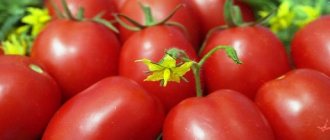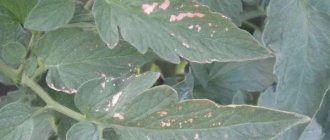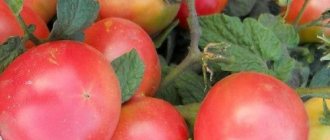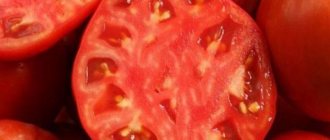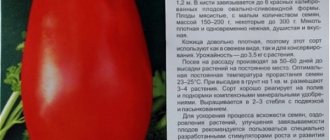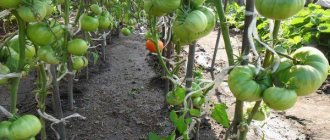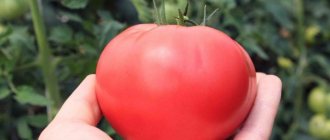Rules for cultivating tomatoes in open ground
The description of the Lakomka variety allows us to classify it as a determinant species of heat-loving vegetable. They prefer to cultivate vegetable plants in open ground. The best way to start growing the variety is to sow tomatoes into seedlings. As usual, planting is carried out 55-60 days before planting the seedlings in the garden.
In mid-May, holes are prepared for seedlings. If frosts still continue, then you can plant tomato seedlings obliquely, covering them with soil on top. A one or two day stay under such a tire is not dangerous for a vegetable crop. Many people use paper caps for each bush as protection. They are rolled from cardboard or newspaper.
Planting scheme for Gourmand tomatoes 60 x 60 centimeters. One square meter can accommodate up to six to seven plants. The volume of the holes for tomato seedlings is 30 x 30 x 30 centimeters. In each planting hole, be sure to put two handfuls of humus, fifty grams of wood ash, mixing all the components with the turf composition of the soil.
The seedlings are immersed in the soil up to the first true leaf, but with elongated seedlings - deeper. After the procedure, the tomato plantation must be watered abundantly. The best time of day for planting seedlings will be evening. This is a guarantee that the seedlings will outpace the plants planted in the morning by two to three days. Two weeks after placing tomato seedlings in open ground, you need to treat the bushes with one percent Bordeaux mixture. This will save them from diseases. Spraying is repeated after ten days.
Although Gourmand is a determinate species, for proper cultivation, the tomato is tied up so that the stems do not break under the weight of the fruit.
Rules for caring for tomatoes in open ground include:
- abundant watering, which is reduced before the plant begins to flower;
- feeding with mullein diluted in a ratio of 1:5, then with minerals - superphosphate, potassium salt, ammonium nitrate;
- weeding of plantings;
- loosening the soil after watering or rain;
- formation of a bush of two or three stems.
In order for tomatoes to ripen faster, be sure to remove the leaves that shade them. If the flowers of tomatoes begin to fall off, then it is necessary to reduce watering, remove excess shoots, and apply phosphorus-potassium fertilizer.
Features of cultivation and storage
To prevent the hybrid from losing its advantage - early ripeness, it is grown through seedlings, sowing 55-60 days before transplanting into open ground. In the middle zone, you can sow throughout March with transplanting to unprotected beds at the end of May - beginning of June. Harvesting begins in July. The fruits ripen until mid-September.
The planting pattern is 40 by 60 cm. The bushes must be pinched, leaving only one lateral shoot extending above the first flower cluster. The fruits can be stored for a short time.
Recommended tomato varieties
Description and agricultural technology of growing hybrid tomato Seven forty
Tomato Seven Forty belongs to the selection of Russian agrobiologists. The early ripening variety is distinguished by a long fruiting period, taste, and resistance to diseases of nightshade crops.
Advantages of a hybrid
Tomato Seven forty F1 belongs to the first generation hybrids. The variety is intended for cultivation in open ground conditions, film greenhouses. An early ripening tomato begins to bear fruit 95-100 days after germination.
During the growing season, the determinate hybrid reaches a height of 70-90 cm. The first peduncle is formed at the level of 5-7 leaves, and subsequent ones are formed at intervals of 1-2 leaves. The inflorescence is simple, 5-7 fruits ripen in the cluster.
The description of the 7/40 variety is associated with the characteristics of the fruits being round in shape. In the ripe phase, tomatoes acquire an intense red color. The stalk has no green spot. When cut horizontally, many chambers with seeds are observed.
The fruits have smooth skin, dense pulp, intense tomato aroma and taste. The fruit weight reaches 220-250 g. The crop yield is 15.5-16 kg per 1 m².
The hybrid is resistant to most diseases of nightshade crops, including Alternaria, blossom-end and root rot, and tobacco mosaic virus. In cooking, the fruits are used fresh, for preparing various dishes, and pickling.
Agrotechnical growing conditions
Tomato is cultivated using the seedling method. Seeds are planted 60 days before planting in the ground. Before sowing, the seeds are treated with an aqueous solution of aloe and a growth stimulator to ensure the smooth emergence of seedlings. The seeds are placed in a container with the prepared soil mixture to a depth of 1 cm.
After watering with warm water using a sprayer, cover the container with film until sprouts appear.
When growing seedlings, it is important to observe the temperature regime, maintaining heat at +23...+25°C. At the stage of 7-10 days of seedlings, plants are culled
Hybrid tomatoes are characterized by a purple marker color with a bronze tint (anthocyanin color). Its absence indicates that the seeds do not meet the quality indicators of current standards.
During the formation of 1-2 true leaves, diving is carried out in separate containers. For this purpose, peat pots are used, with which it is convenient to transfer formed seedlings with 1 peduncle to a permanent place.
The plant requires moderate watering as the topsoil dries out. You can provide drip irrigation and prevent the growth of weeds using non-woven fiber. The use of organic materials (straw, leaves) as mulch serves as a source of nutrition for tomatoes during the period of growth and fruiting.
The hybrid is responsive to the application of complex fertilizers. To ensure a balance of moisture and air near the root system, the soil is periodically loosened. Hilling up bushes stimulates the formation of additional roots, which improves plant nutrition.
The bushes grow in 1-2 stems, and the stepsons are periodically removed. Plants require tying to a support.
Opinions and recommendations of gardeners
Reviews from vegetable growers indicate the positive characteristics of the variety. The hybrid is resistant to cracking during ripening, adapts well to high temperatures, and can easily be transported over distances.
Valery Efimov, 53 years old, Voronezh.
Last season, I planted the Seven Magpie tomato in the greenhouse for the first time. I was pleased with the opportunity to pick fresh tomatoes from the bush for a long period of time. The fruits are very tasty, aromatic, with dense pulp. Excellent for canning and processing into sauce.
Margarita Antonova, 56 years old, Adler.
Seven forty tomatoes were planted in open ground. I purchased the seeds from a well-known brand. I was convinced of the quality of the material after the sprouts appeared, which had a characteristic purple hue.
Before sowing, the seeds were treated with a growth stimulator. The variety pleased with its taste, high yield, fruits of the same size, with dense pulp. The description fully corresponds to the information on the packaging.
The hybrid is highly resistant to diseases and biological pests.
Sowing and care
Tomatoes are very heat-loving, so they are grown only in seedlings. Seeds are planted in March-April, 60 days before planting in a permanent place. Growing requires following some rules. Seeds are germinated in damp gauze bags at room temperature. Those seeds that have sprouted must be planted in the ground and covered with film.
Afterwards, they are placed in separate jars at the rate of one root per jar. It is necessary to water frequently, 2-3 times a week.
Planting can be done only after the end of frost and the formation of permanent warm weather, otherwise your plants will die. It is usually carried out in May-June at the rate of 3 roots per 1 m2. Watering is carried out every other day.
It is necessary to water tomatoes at the root. On particularly hot days, it is possible to spray the entire stem. Two weeks after planting, you can apply fertilizer. The following fertilizing should be carried out during abundant flowering, fruit set and ripening. It is imperative to carry out regular stepsoning. Fruits appear in 3-4 weeks, 6 pieces in a nest. They begin to sing after 2-3 weeks.
See also
Characteristics and description of the tomato variety Novichok, yield and cultivationRead
In the middle or end of August, it is necessary to stop the growth of the stem due to the end of the season and allow all the formed ovaries to mature. To do this, cut off the tops and monitor the formation of stepsons, which also need to be removed. Before the first frost, it is necessary to collect all the tomatoes, regardless of their ripeness. Otherwise, your harvest may be lost.
Main characteristics
Typically, salad tomatoes are grown in greenhouses so that the fruits have time to ripen under the most favorable conditions. In this case, the dry matter and sugar content reach maximum values. But the Slavyanin variety is intended for cultivation in unprotected soil conditions. Temporary shelter is used only at the initial stage, when planting seedlings earlier in the ground. Let's look at the description of the variety by the seed manufacturer:
The tomato is mid-season, with a growing season of 110–115 days. Therefore, it is grown using seedlings.
- The plant is determinate, well-leafed, reaches a height of 1.3 meters, requires removal of stepsons. Leave 2 trunks on the bush, tying them to a support.
- The fruits are a delicate crimson color, pear-shaped with ribs at the base, weighing 100–135 g. Dense pulp containing a high proportion of dry matter.
- Slavyanina tomatoes are sweet, universally used. The skin does not crack during heat treatment, which allows the tomatoes to be used for pickling and pickling.
The combination of characteristics speaks of an interesting variety with a rare combination of technical consumer qualities. Reviews from gardeners also characterize the plant as an unpretentious and very reliable variety. But they note that when grown in a greenhouse, the plant becomes pampered and behaves like an indent, continuing intensive, unlimited growth.
Important! The advantage of determinate tomatoes is the early harvest. Excess shoots are removed so as not to end up with a plant overloaded with fruits.
Tomato Heinz - description and characteristics of the variety
The tomato variety is quite common and attracts gardeners for many reasons: large, tasty fruits, ease of care, the ability to eat fresh and make preparations for the winter. Let us consider below what the features of the variety are, how to grow tomatoes correctly and what their advantages are.
Characteristics
So, let’s look at the reasons why the Heinz variety attracts gardeners and farmers:
- can be grown both in open ground and in a greenhouse;
- bears fruit 85-110 days after germination;
- bushes are strong, fleshy, have a good root system;
- has the ability to actively increase green mass;
- has large, succulent leaves;
- the plant is resistant to many diseases;
- fruits – juicy, tasty;
- the seeds germinate in more than 90%, which is a high figure.
Tomatoes of this variety tolerate transportation well and can be stored for a long time. Tomato ripening is consistent. When choosing this type of tomato, you can be sure: you will be pleasantly pleased with the harvest if you follow all the recommendations regarding planting and care.
Description of the variety
The biggest feature is the ideal taste characteristics of tomatoes. Let's look at the features of tomatoes in detail:
- The maximum weight of one tomato can reach 60-150 g.
- Productivity - from 100-120 tons/hectare.
- The fruits are plum shaped.
- Tomatoes have a thick skin.
- The color of the tomato is bright red and looks presentable.
- It has juicy pulp with a large number of grains.
- The berries have a pleasant sweet and sour taste.
This variety is more popular among farmers. Tomatoes are in demand by consumers: they are perfect for preparing winter wraps, and when fresh they can be added to salads. Many housewives prefer to make tomato juice from this variety of tomatoes. The fruits tolerate transportation well and do not lose their presentable appearance. Stored for a long time in a dry, dark place.
What aspects should you pay attention to in order to get a good harvest?
The Heinz variety has many hybrids; all varieties ripen together, which is especially convenient for gardeners. To get a good harvest, experts recommend following these recommendations:
If you plan to plant plants in open ground, you need to immediately select the most illuminated place. Calculate in advance how many seedlings will be needed due to the fact that forcing is carried out at different times. The containers where planting will take place must be disinfected (potassium permanganate or vodka is used for this). The soil needs to be prepared in advance (it is sold in specialty stores already prepared, or you can make it yourself: peat + compost + turf soil). Before preparing the soil mixture, all ingredients must be frozen for about one week. Seeds must be prepared: assess germination, place in potassium permanganate for disinfection, and keep in a stimulator for 30 minutes. During germination, it is important that it is warm - at least 25 ⁰C. Make sure there is gas exchange. When the first loops appear, the temperature must be reduced to +18 ⁰C.
The variety is popular among gardeners due to the fact that it tolerates adverse weather conditions well: sudden temperature changes, lack of sufficient moisture, etc. Plants tolerate both heat and cold and continue to bear fruit.
Agricultural technology
So, now let's look at what steps need to be followed in order to grow good, strong plants and get an excellent harvest.
How to plant. Soak the seeds and place them 1 cm deep in previously prepared soil. Afterwards, they need to be covered with film. As soon as leaves begin to form (minimum 2), the sprouts are transplanted into separate containers
It is important that the seedlings receive enough light, and the plants also need to be fertilized periodically in order to get a good harvest in the future. After about 2 months, the seedlings will have become stronger and can be moved into open ground.
How to grow
The bushes should be placed at a distance of 30 cm from each other. It is not necessary to remove the lower shoots, but a garter is needed. Don’t forget about care: water regularly, loosen the soil, add fertilizers.
Harvesting. You can start collecting at the end of July. Due to the fact that the fruits ripen in waves, they need to be collected as they ripen. Tomatoes have an excellent taste - they can be used fresh, heat-treated, or canned.
As you can see, this variety really has excellent characteristics. It is widespread both among consumers and among farmers due to the fact that the plants are easy to care for, they are not susceptible to diseases, produce an excellent harvest and at the same time have excellent taste.
Customers' opinions
Here are reviews from some buyers of this variety.
- Maxim: I planted it for the first time. Very tasty. High yield. I will plant next year.
- Olga: The description matches. Not fussy, high yield. I planted 5 roots in the greenhouse for testing. Almost every day I picked several ripe tomatoes. I recommend it to everyone. Next year I will plant the entire greenhouse with this variety. Very pleased.
- Anton: I planted it on the balcony. It does not affect the yield - everything is as written on the package. I recommend this variety of tomatoes to everyone.
- Masha: I decided to start my experience in growing tomatoes with this variety. I only planted 10 roots. I was afraid they wouldn't grow as much as they should. And it turned out to be wrong. We grew up together. There are many ovaries. There were no pests. Very easy to care for: just water and tie up. Next year I will plant more.
- Ekaterina: I am an experienced gardener. But even with this variety I was pleasantly surprised. The tomatoes are even and ripening together. Almost every day I collected so many ripe tomatoes that it was enough to eat and make 1 jar for pickling.
- Mikhail: I planted this variety of tomatoes in the garden in a film greenhouse. Good variety. The tomatoes grew smooth and tasty. They ripened already in early July.
The Seven Forty tomato hybrid will provide you with a large tomato harvest and no hassle in dealing with various pests. By watering and caring for it on time, it will respond to you with gratitude. And the tasty and aromatic fruits will not leave anyone indifferent. Even in winter, when you try a jar of pickled or canned tomatoes, they will be just as tasty and aromatic as in summer.
Tomato Seven forty F1 can be grown in regions with temperate climates. This is a first generation hybrid. It is resistant to diseases and produces transportable, tasty, abundant fruits. The tomato is suitable for summer residents who have the most primitive greenhouses or those who prefer to grow tomatoes without shelter.
| Height | Landing location | Ripening time | Fruit color | Fruit size | Origin | Fruit shape |
| Medium height | Open ground | Early ripening | Reds | Large | Hybrid | Flat-round |
Growing tomatoes
Tomato seedlings can be planted both in a greenhouse structure and in unprotected soil. If you plant the seedlings early in the greenhouse, you can get a double harvest due to the appearance of young shoots after the first harvest has been harvested.
Description:
- Planting of seed material is carried out in the last days of March - in the first days of April. This will allow the seedlings to gain strength and grow by receiving sufficient sunlight and heat;
- The containers are filled with a pre-prepared substrate, into which the seed material is buried 1 cm;
- Then water it with water from a spray bottle and cover it with film until the sprouts sprout;
- At the stage of forming a pair of full-fledged leaves, the seedlings are planted. Peat pots are perfect for containers; they are best used for replanting to a permanent location.
Description:
- At the age of 45-50 days and in the presence of 5-6 well-developed leaves, the seedlings are planted in a permanent place;
- They are mainly planted in the last days of May or in the first ten days of June. Specific dates are usually determined by the climatic characteristics of the region, as well as weather conditions;
- The bed is pre-prepared and fertilized with organic matter.
For beginning gardeners, there is simply no better variety of tomatoes. The bushes develop well and bear fruit in dense or loose soil. At the same time, they can be planted densely. When planting six bushes on one square meter, the harvest is very generous. With proper and very easy care, you will get at least 16 kg of wonderful tomatoes from one m2.
In central Russia and further north, seedlings have to be grown.
Plant the seedlings in the beds after the threat of May frosts has passed. In Central Russia and the Moscow region, this is best done with the onset of calendar summer. Plant the bushes every 40 cm from each other, and the distance between the rows should be at least 60 cm. As you can see, the planting will be very dense. However, there is no need to be afraid of this. In this case, the plants will have enough light and fresh air. By July, be ready to harvest.
The Aurora-F1 hybrid is not capricious. Gardeners like this feature. Water the bushes only as needed, when the top layer of soil dries to a depth of 2-3 cm. Water for irrigation should be clean and its temperature should not be lower than 15 degrees.
Due to the density of planting, weeds do not grow actively in the area under these tomatoes. Usually you have to weed the beds no more than twice a season. The first time this is done is when the stems of neighboring bushes begin to touch.
Tomato seeds are sown in plastic cups or small containers. The containers are first disinfected. Drainage holes should be made at the bottom.
A mixture of peat and sand, taken in equal proportions, is used as a substrate. You can use a universal soil solution, purchasing it at the store.
Description of sowing Aurora tomato.
- To improve the sowing qualities of the seeds, they are dried.
- Planting can be done with dry seeds or soaking them in potassium permanganate. They stay there for 10 minutes and then are washed in running water.
- Aurora f1 tomato seeds are planted in moist soil. The top is covered with a film to retain moisture.
- Sowing is done sparsely so that the seedlings are not very thin.
We invite you to familiarize yourself with Sero Blackburn – Albums
With the appearance of the first seedlings, the film is removed. If necessary, plants are watered with a spray bottle.
This work is carried out carefully so as not to break the stems
Seedlings must be hardened, maintaining daytime temperatures of up to 15 degrees, and night temperatures of up to 10.
Planting dates and care
There is nothing special in caring for the variety, but Bear’s Blood cannot be called a tomato for the lazy. It requires compliance with at least basic rules of agricultural technology.
Growing seedlings
From the moment the seeds hatch until they are planted in the ground, 45-55 days should pass. To calculate the sowing time, you need to focus on your own climate and long-term weather forecast. A week is added to the specified time for the preparation and germination of planting material.
Before sowing, the seeds are heated, disinfected, and soaked until they swell. Their germination rate is good. They dive after 1-2 true leaves appear. Water moderately, add light up to 12-14 hours a day. Hardening is carried out 2 weeks before planting.
Care after transplanting into the ground
Bear's blood is planted at 4-5 bushes per 1 square meter. m. Care is as follows:
- regular moderate watering;
- loosening or mulching beds;
- stepsoning;
- garter;
- fertilizing with a mineral complex - in the first half of the growing season with a large amount of nitrogen, after the extension of the second flower cluster, phosphorus, potassium, and calcium should predominate in the fertilizers;
- removing leaves under the fruit cluster that has begun to fill.
Features of care
With proper agricultural technology, the bush is low and medium-leafed. If nitrogen fertilizing is not controlled, the seedlings will stretch out. True, after moving into the ground it quickly grows stronger, the trunk becomes thick, and the internodes do not seem elongated.
But when gardeners continue to be zealous with nitrogen, the tomato:
- reaches a greater height than indicated in the variety description;
- builds up a powerful leaf apparatus, which delays flowering and ovary formation;
- the fruits become smaller.
This is confirmed not only by reviews of the Bear’s Blood tomato, but also by the few videos so far (see below).
To correct the situation, it is enough to follow the requirements of growing the crop. Namely, after the second flower cluster begins to extend, stop giving nitrogen. If the soil has been filled with organic matter since autumn or spring - completely. Otherwise, the crop will only need very small doses of N, and it is better to apply them by spraying the above-ground parts. So the bushes are unlikely to fatten.
It is better not to rush, and open the greenhouses only during the day. It is recommended to completely remove the film no earlier than the beginning of June, and it is definitely not worth removing it in May.
Disease resistance of the variety
Explosion tomatoes withstand drought well. They are suitable for working gardeners who grow crops in their dachas without automated watering. If the soil is not regularly moistened, the number of cracked fruits will be minimal.
Explosion tomatoes are highly resistant to various rots, including blossom end rot. It also suffers less from late blight than other varieties, although the main crop yields before the massive development of the disease. This does not mean that preventive treatments can be ignored. It’s just that their effectiveness on Explosion tomatoes is higher than when spraying other varieties.
Growing rules
The agricultural technology of the Nastena-slastena tomato, according to reviews from those who have been involved in the crop for a single year, is practically no different from other varieties:
- growing seedlings;
- landing in a permanent place;
- watering and weeding;
- loosening the soil and mulching;
- feeding and protection from diseases.
Planting seedlings
Tomatoes of the Nastya-slastena variety are best grown in seedlings, despite the early ripeness of the plant.
Sowing is scheduled for mid-March or early April. It all depends on the climatic conditions of the region. You just need to count 60 days from the intended planting of seedlings in a permanent place.
Preparing containers and soil
You can plant seeds in different ways:
- into containers;
- into the snail;
- in peat pots or tablets.
You can take ready-made soil or prepare it yourself. You need to take equal parts of ordinary soil and humus, add sand and wood ash.
Before sowing tomato seeds, the container and soil are spilled with boiling water, adding several crystals of potassium permanganate to it. This is a necessary measure for the prevention of fungal diseases and the destruction of pests.
Sowing seeds and caring for seedlings
Before planting, seeds are soaked for 30 minutes in a pink solution of potassium permanganate or in any growth stimulant in accordance with the instructions.
The seed is buried 1 cm. The distance between the furrows is 3 cm. The soil is moistened, the container is covered with film and placed on a lighted window. The best temperature for seed germination is 22-24 degrees. When the first shoots appear, the film is removed.
Further care for Nastya-slastena tomato seedlings comes down to watering and superficial loosening of the soil. You can feed the plants with a solution of wood ash.
Comment! Under no circumstances should excessive watering be allowed, as this may cause damage to the root system by blackleg.
Dive
Transplanting tomatoes is a necessary condition for obtaining plants with a powerful stem and a well-developed root system.
When the 3rd leaf appears on the Nastena-slastena tomato, it’s time to pick. It is advisable to use the same soil as when sowing seeds. The seedlings are watered and selected with a clod of earth. Make a hole in the pot and place the seedling up to the cotyledon leaf. After transplanting, water the soil with warm water.
2 weeks before planting in a permanent place, seedlings of the Nastya-slastena variety are hardened off. They are taken outside and gradually accustomed to new conditions. As a rule, at the time of planting, the bushes have the first cluster of green fruits.
Transfer
If the greenhouse is heated, Nastya the Sweet Tomato seedlings can be transplanted into it in mid-May. As usual - in early May. These terms are approximate, since they depend on the climate zone in which the gardener lives.
Seedlings can be planted in open ground after a stable positive temperature has been established. And, most importantly, the morning frosts will not return.
Planting pattern for tomatoes Nastya-slastena 30x50 cm in a checkerboard pattern.
Landing rules
The holes are prepared 14 days before planting so that the soil has time to settle. You need to add humus to each hole and pour it well with hot water and potassium permanganate.
Attention! Nastya does not recommend fresh manure for fertilizing tomato seedlings, as it promotes the growth of green mass. The seedlings are watered to make it easier to remove from the cup
Plant in the center of the hole, compact the soil and water
The seedlings are watered to make it easier to remove from the cup. Plant in the center of the hole, compact the soil and water.
Important! The leaves under the first brush need to be torn off to speed up the establishment of seedlings
Aftercare
The formation of Nastya-sweetness hybrid bushes is carried out after 2 weeks, when the plants take root. The best harvest is obtained on bushes grown in 2 or 3 stems. Stepchildren must be removed throughout the growing season.
The description says that the Slastena tomato is a tall plant, so you will have to take care of tying it up. To do this, immediately after planting, install long stakes or stretch a trellis. It is necessary to tie not only the stems, but also the brushes themselves, as they can break off under the weight of the fruit. The first time they grab the stem at a level of 20-30 cm.
All other activities are the same as for other tomatoes: watering, loosening, removing weeds, mulching and fertilizing.
To feed the bushes, you can use an infusion of mullein, chicken droppings, and green grass. Wood ash is sprinkled under each bush as a top dressing and prevention against diseases. It is useful to sprinkle the leaves with this substance.
You shouldn’t forget about foliar feeding either. The Nastena sweet variety responds well to boric acid and iodine. This is not just additional nutrition. The plants' immunity is strengthened, the fruits fill and ripen faster.
Description and characteristics of the variety
Seven forty F1 is a low-growing, large-fruited hybrid for open ground and spring film unheated greenhouses. It was bred by breeder Mashtakov, the author of other popular varieties and hybrids: Black Prince, Infinity, Black Moor. Mashtakov lives and works in the Rostov region, so his cultivars are perfectly suited for areas with arid, hot climates.
The hybrid is recommended for cultivation in the regions:
- North and North-West of Russia,
- Volgo-Vyatsky,
- Central Black Earth Region
- North Caucasus,
- Middle Volga,
- Central.
The cultivar was included in the State Register in 2010.
The fruits of the hybrid are flat-round, hard, smooth, bright red. The taste is excellent.
Tomatoes have 6 or more nests, the flesh is dense, the seed chambers are small and contain very few seeds. This makes them suitable for processing into thick tomato products: paste, ketchup, sauces.
The fruits ripen on the 98th day after full germination, so experts classify the variety as early ripening. It is noteworthy that despite the large fruit, the harvest is still early.
Plants stop lengthening on their own, having reached a height of 70-90 cm. The bushes form powerful and require mandatory garter.
Opinions and recommendations of gardeners
Reviews from vegetable growers indicate the positive characteristics of the variety. The hybrid is resistant to cracking during ripening, adapts well to high temperatures, and can easily be transported over distances.
Valery Efimov, 53 years old, Voronezh.
Last season, I planted the Seven Magpie tomato in the greenhouse for the first time. I was pleased with the opportunity to pick fresh tomatoes from the bush for a long period of time. The fruits are very tasty, aromatic, with dense pulp. Excellent for canning and processing into sauce.
Margarita Antonova, 56 years old, Adler.
Seven forty tomatoes were planted in open ground. I purchased the seeds from a well-known brand. I was convinced of the quality of the material after the sprouts appeared, which had a characteristic purple hue. Before sowing, the seeds were treated with a growth stimulator. The variety pleased with its taste, high yield, fruits of the same size, with dense pulp. The description fully corresponds to the information on the packaging. The hybrid is highly resistant to diseases and biological pests.
Tomato Seven forty F1 can be grown in regions with temperate climates. This is a first generation hybrid. It is resistant to diseases and produces transportable, tasty, abundant fruits. The tomato is suitable for summer residents who have the most primitive greenhouses or those who prefer to grow tomatoes without shelter.
| Height | Landing location | Ripening time | Fruit color | Fruit size | Origin | Fruit shape |
| Medium height | Open ground | Early ripening | Reds | Large | Hybrid | Flat-round |
New hybrid Nastena F1 description
The Nasten hybrid is already 10 years old, it was bred by breeders Yu.I. Panchev and V.V. Zazimko for use in open ground. The variety was tested in the Central Black Earth region, recommended for personal consumption and cultivation for sale in small farms.
The first generation hybrid is not inferior to its foreign analogues in disease resistance. Shows good resistance to a number of diseases:
- Verticillium.
- Late blight.
- VTM.
- Alternaria.
The undoubted advantages include the hybrid’s insusceptibility to temporary drops in temperature and waterlogging of the soil.
Description
This is an early ripening variety of red tomatoes, for growing in unheated film greenhouses and open ground. The variety grows up to 90 cm in height. The harvest is harvested from July to September. The characteristics of tomatoes seven 40 allow it to be used for canning.
Tomato seven forty reduces cholesterol levels in the blood and is recommended for diseases of the gastrointestinal tract (easily digested and absorbed).
Varieties of this type have the following properties:
- High yield – 15 kg/m2;
- Resistance to many diseases and viruses;
- Fragrant and tasty;
- Flameproof.
Fruit characteristics:
- Rounded-elongated shape;
- Large ones weighing up to 300 g;
- Dense;
- Smooth;
- Long shelf life;
- Resistant to cracking.
Seven Forty - variety of tomato plant
Information on the admission of Tomato Seven Forty from the Register of the State Variety Commission of the Russian Federation
Application for admission No. 52584, registered 2009-09-07. The Tomato variety Seven Forty was included in the register of those approved in 2010. Approved for use in the regions: Northern, Northwestern, Central, Volga-Vyatka, Central Black Earth, North Caucasus, Middle Volga.
The originator of the Tomato Seven Forty variety is:
MASHTAKOV ALEXEY ALEKSEEVICH
Other varieties of tomato plant
Add new comment
Register or Login so you don't have to enter your Name and Email every time
Thanks for the comment! It will be published after checking by a moderator!
No comments yet, be the first!
A portal for those who love their dacha
Thanks for your question!
Your question has been sent for moderation. Don't worry, we quickly check your questions and your question will be answered within 1 day.
We have noticed that you are already registered on our website. We recommend that you log in to view the created question.
If you don't remember your password, you can recover it.
You were not registered until today, so we have registered you. Your password has been sent to your specified mailbox.
Help our site develop!
Please read this message, it will not take up much of your time!
We so need your comments and questions to understand in which direction we should develop.
Don't forget to leave a comment if you found what you were looking for. And if you haven’t found it, use the “Ask an Expert” form in the site header. We will answer this question, and other visitors will be able to find the information that you could not find.
Thanks for your question!
Your question has been sent for moderation. Don't worry, we quickly check your questions and your question will be answered within 1 day.
We have noticed that you are already registered on our website. We recommend that you log in to view the created question.
If you don't remember your password, you can recover it.
You were not registered until today, so we have registered you. Your password has been sent to your specified mailbox.
Tomatoes seven forty reviews photos
Nov 15 • Uncategorized • 78 Views • No comments on Tomatoes seven forty reviews photo
Contents
Tomatoes are the most common vegetable crop along with potatoes and cucumbers, which every self-respecting gardener considers it his duty to plant and grow.
Currently, a huge variety of varieties of different colors and ripening periods have been developed. One of them is the Seven Forty F1 tomato, which has gained popularity among farmers due to its taste and other properties, as well as reviews.
Description and characteristics of the variety
The tomato variety Nastenka is registered by the agro and peasant (farm) farm Kondakov S.N. Year of inclusion in the State Register - 2008. Recommended for growing under film and in the garden in all regions. Planting in permanent greenhouses is possible.
Description of the bush
Tomato Nastenka forms a low, semi-standard bush with determinant (limited) growth:
- in the garden - 70 cm;
- in the greenhouse - 90 cm.
The shoots are thick and strong. Even seedlings always turn out stocky and do not tend to stretch out. The leaves are green, small, juicy, with clear veins. With regular watering, they accumulate a sufficient supply of moisture so as not to wither in the heat.
An average number of shoots and leaves are formed. This makes the bush light, it is well ventilated, which reduces the likelihood of infectious diseases.
Fruit characteristics
Nastenka tomatoes are collected in simple clusters of 5-8 pieces. They are beautiful, which can be clearly seen in the photo; at the technical stage they are green, after full ripening they are deep pink. The shape of tomatoes is similar to a heart, but not a stylized one, but a real one - a short oval with a swelling in the middle and a slight narrowing at the end. There are more than 6 chambers, the ribs are weakly expressed, and there are few seeds.
The weight of the fruit depends on whether the bush will be formed and the ovaries pinched:
- if these operations are ignored, the weight is about 120-130 g, the plant is literally strewn with medium-sized tomatoes;
- with careful pinching and maintaining 2-3 trunks, the weight increases to 200, and in some fruits - 300 g;
- By adding normalization of the ovaries (pinching the brushes) to the removal of the lateral processes, you can grow half-kilogram giants.
The taste of Nastenka's fruits is delicate and sweet. Those who have planted the variety claim that it is one of the best pink tomatoes for problematic climates.
The pulp contains enough juice and is grainy when cut. The skin is strong, but not rough. Tomatoes are eaten fresh, processed into juice, paste, salted, canned whole, and prepared in winter salads.
Productivity
2-2.5 kg are harvested from a bush per season. Thanks to resistance to late blight, new fruit clusters can appear until it gets cool outside, and tomatoes ripen until frost.
The harvest per square meter depends on the planting density. Maximum of 10-12 kg per 1 sq. m. achieved when grown in greenhouses or under film, maintained in 1 trunk. The weight and number of tomatoes do not affect the overall yield from the bush.
The marketability of fruits can be significantly reduced by uneven watering - tomatoes are prone to cracking.
